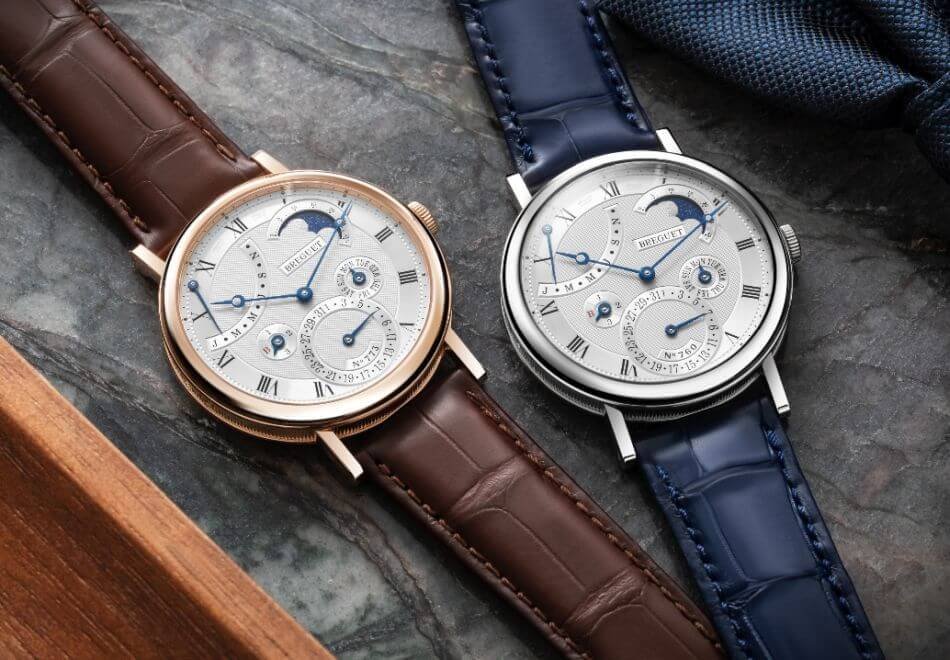In 1780, Abraham-Louis Breguet invented a perpetual repeating watch equipped with a “shaking” oscillating weight allowing the caliber to react to body movements and thus automatically rewind the mechanism as the wearer walks.
Moreover, this innovation associated with a calendar mechanism was among the first to display a silver guilloché dial. In 2023, Breguet is paying homage to this historic model in its Classique collection with a reinterpretation of the perpetual calendar available in two golds under the reference 7327.
The perpetual calendar is one of the “queen” functions of watchmaking. It was born in the 18th century and allows the display of the exact date to infinity, taking into account the variable length of the months and the cycle of leap years.
To accomplish this mechanical feat, the movement must have a mechanical “memory” of four years, or 1,461 days. As such, this novelty features the automatic Breguet 502.3.P caliber (QP module) with gold oscillating weight, 294 components, clocked at 3Hz and with a 45-hour power reserve. With its thickness of 4.5 mm, this movement thus remains at present one of the thinnest from Breguet.
“Its design has been thought out to provide top-flight performance despite its low thickness” assures the brand in its press release. Its barrel is open to gain finesse while guaranteeing constant and efficient energy”.
Its oscillating mass is off-centered to grant maximum space to the main elements of the
movement. It is thus integrated into a minimum of thickness. This winding movement
automatic is rhodium-plated. It is equipped with a flat silicon hairspring and an inverted in-line lever escapement with silicon lugs.
The properties of silicon are multiple. In addition to being resistant to corrosion as well as
wear, it is insensitive to the influence of magnetic fields and improves the precision of the timepiece.
This caliber can be admired through the sapphire crystal case back and highlights a skill dear to Breguet: decoration. Thus, the gold oscillating weight is guilloché by hand with a circular barleycorn pattern, the bridges display Côtes de Genève, while the other components are finished in chamfered finishes as well as Côtes de Genève. A know-how carried out by craftsmen in a factory located in the heart of the Vallée de Joux.
This new creation signed Breguet is offered with an aesthetic reminiscent of the brand’s distinctive signs: a very fine Clous de Paris decoration, referring to that present on the timepieces created by Abraham-Louis Breguet, adorns the dial.
Located at 1:30, the moon phase has been designed to provide strong realism, for this reason its surface has been hammered by hand. Its sky is coated with a blue lacquer composed of sequins subtly revealing the stars according to the orientation of the timepiece.
The day, date and year indicators appear at the bottom of the dial. A quarter-circle located at 10.30 o’clock indicates the months via a retrograde hand. The traditional off-centred, hollowed-out “apple” hands in blued steel signed Breguet are responsible for indicating the hours and minutes. Breguet’s secret signature, initiated by the house’s founder in 1795, is revealed between 11 and 12 o’clock and between 12 and 1 o’clock.
Finally, the settings for the various indications present on the dial are located in several places on its 39 mm case. A corrective stylus allows adjustment at 4 o’clock, the day; at 4:30 a.m., the different moon phases; at 6 o’clock the date and finally at 9 o’clock the month and the year. The time setting is modified via the crown nestled at 3 o’clock.
This new timepiece (water-resistant to 30 meters) is offered on a strap in midnight blue for the white gold model and mysterious brown for the rose gold version.






